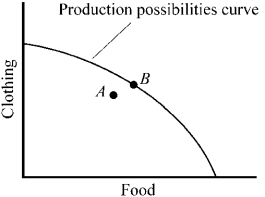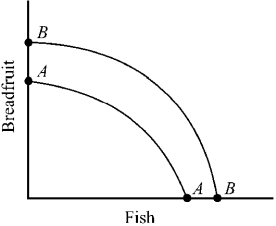A) individuals, states, and nations can all benefit if they trade with others.
B) free trade among nations is harmful to an economy.
C) each economy should strive to be self-sufficient.
D) each country should attempt to produce roughly equal amounts of all goods.
F) A) and C)
Correct Answer

verified
Correct Answer
verified
Multiple Choice
Which of the following is true regarding value, transaction costs, and exchange?
A) Middlemen can be viewed as agents who create value by reducing transaction costs and, thereby, facilitating gains from exchange.
B) Middlemen fail to create value since they do not expand the supply of physical goods.
C) A good or service has a given value regardless of who uses it or how it is used.
D) Voluntary exchange reduces value by channeling goods into the hands of people who value them least.
F) A) and D)
Correct Answer

verified
Correct Answer
verified
Multiple Choice
Which of the following is true of a production possibilities curve?
A) It reveals the maximum amount of any two goods that can be produced from a fixed quantity of resources.
B) It reveals the ideal level of technology for a country.
C) It assumes that the prices of the two products are equal.
D) For a country that could produce many different goods, it shows which two goods are most important to produce.
F) A) and B)
Correct Answer

verified
Correct Answer
verified
Multiple Choice
In voluntary exchange, if the seller of a product gains,
A) the buyer will generally lose an amount greater than the gain to the seller.
B) the buyer must lose an amount equal to what the seller gains.
C) someone else must lose an equal amount.
D) the buyer must also gain; mutual gain provides the foundation for exchange.
F) A) and C)
Correct Answer

verified
Correct Answer
verified
Multiple Choice
"If I didn't have a date tonight, I could save $40 and spend this evening out with my friends." The opportunity cost of the date is
A) $40.
B) $40 plus the cost of forgoing a night out with friends.
C) dependent on how pleasant a time one has on the date.
D) the cost of forgoing a night with friends.
F) A) and D)
Correct Answer

verified
Correct Answer
verified
Multiple Choice
In an informed and voluntary exchange,
A) both parties receive something they value more than what they gave up.
B) both parties place an equal value on what they received and what they gave up.
C) neither party can gain more than the other.
D) one trader can gain only at the expense of the other.
F) A) and C)
Correct Answer

verified
Correct Answer
verified
Multiple Choice
Figure 2-1
 -In Figure 2-1, point A is
-In Figure 2-1, point A is
A) unattainable.
B) inefficient.
C) efficient.
D) preferable to point B.
F) A) and C)
Correct Answer

verified
Correct Answer
verified
Multiple Choice
Figure 2-6
 -Which of the following will most likely shift the production possibilities curve for breadfruit and fish outward from AA to BB in Figure 2-6?
-Which of the following will most likely shift the production possibilities curve for breadfruit and fish outward from AA to BB in Figure 2-6?
A) an improvement in the form of economic organization
B) lower investment and a reduction in the country's capital stock
C) an increase in the price of breadfruit
D) a decrease in the average number of hours worked
F) B) and C)
Correct Answer

verified
Correct Answer
verified
Multiple Choice
The successful introduction and adoption of a new product or process is known as
A) invention.
B) innovation.
C) origination.
D) adaptation.
F) C) and D)
Correct Answer

verified
Correct Answer
verified
Multiple Choice
Why is trade an important source of economic progress?
A) It allows the trading partners to produce a larger joint output through specialization in the areas where they have a comparative advantage.
B) It allows the trading partners to produce a larger joint output as the result of greater realization of cost reductions that accompany the adoption of mass production methods.
C) It makes it possible to realize gains from the discovery and dissemination of innovative products and production processes.
D) All of the above are correct.
F) A) and D)
Correct Answer

verified
Correct Answer
verified
Multiple Choice
When resources are being used wastefully or inefficiently, the
A) production possibilities curve shifts inward.
B) production possibilities curve shifts outward.
C) economy is operating at a point inside its production possibilities constraint.
D) economy is operating at a point outside its production possibilities constraint.
F) A) and B)
Correct Answer

verified
Correct Answer
verified
Multiple Choice
Which of the following is true of exchange?
A) Exchange is a zero sum activity; if one party to an exchange gains, the other must lose an equal amount.
B) The exchange value of a good is determined by the cost of the resources required to produce the good.
C) The total output trading partners are able to produce is not influenced by whether the partners trade with each other.
D) Exchange permits trading partners to expand their total output of goods and services as the result of greater specialization in areas where each has a comparative advantage.
F) B) and C)
Correct Answer

verified
Correct Answer
verified
Multiple Choice
Even countries that depend primarily on market forces to resolve the basic economic questions will usually rely on the collective decision-making process to
A) determine the prices of goods and resources.
B) allocate goods that are essential to life.
C) determine the distribution of income among citizens.
D) define and enforce private-property rights and designate the acceptable forms of competitive economic behavior.
F) A) and D)
Correct Answer

verified
Correct Answer
verified
Multiple Choice
A middleman is a person who
A) specializes in arranging trades and selling, guaranteeing, and servicing items traded.
B) acts as a middle person between the top management of a business firm and the hourly employees who actually produce the goods and services.
C) adds to the seller's expense and the buyer's buying price without providing a service to either.
D) levies a tax on private sector activity and uses the funds to support government activities.
F) A) and C)
Correct Answer

verified
Correct Answer
verified
Multiple Choice
When collective decision making is utilized to resolve economic questions regarding the allocation of resources,
A) the role of markets will be replaced by political decision making.
B) centralized decision making in all areas is inevitable.
C) the preferences of individuals are of no importance.
D) economic efficiency will be assured.
F) A) and C)
Correct Answer

verified
Correct Answer
verified
Multiple Choice
The reason that the production possibilities curve is usually a bow-shaped curve instead of a straight line is that
A) it makes it easier to illustrate the concepts of scarcity and prices with a bow-shaped curve than it is with a straight line
B) early economists began drawing them in this way and the convention has continued throughout the years
C) output eventually reaches a maximum and then declines
D) resources are not perfectly adaptable to the production of all goods
F) A) and B)
Correct Answer

verified
Correct Answer
verified
Multiple Choice
Which of the following is true of private ownership?
A) Private ownership links responsibility with the right of control.
B) Private owners have little incentive to conserve natural resources for the future.
C) Private owners have little incentive to develop and use their assets in ways others value.
D) Private owners can do anything they want with the things they own regardless of the damage it does to the property of others.
F) B) and C)
Correct Answer

verified
Correct Answer
verified
Multiple Choice
In a market economy, what is produced is ultimately determined by
A) consumers.
B) producers.
C) the government.
D) exporters.
F) A) and D)
Correct Answer

verified
Correct Answer
verified
Multiple Choice
Three basic decisions must be made by all economies. What are they?
A) How much will be produced; when will it be produced; who will produce it?
B) What goods will be produced; how will goods be produced; for whom will goods be produced?
C) What will be consumed; how will goods be consumed; for whom will goods be consumed?
D) How will the opportunity cost principle be applied; if the law of comparative advantage will be utilized, how will it be utilized; will the production possibilities constraint apply?
F) A) and C)
Correct Answer

verified
Correct Answer
verified
Multiple Choice
Using a production possibilities curve, a technological advance that increases the amount of output for the same amount of inputs would be illustrated as
A) an inward shift of the curve.
B) a movement from one point to another point along the curve.
C) an outward shift of the curve.
D) a movement from a point on the curve to a point inside the curve.
F) All of the above
Correct Answer

verified
Correct Answer
verified
Showing 121 - 140 of 224
Related Exams